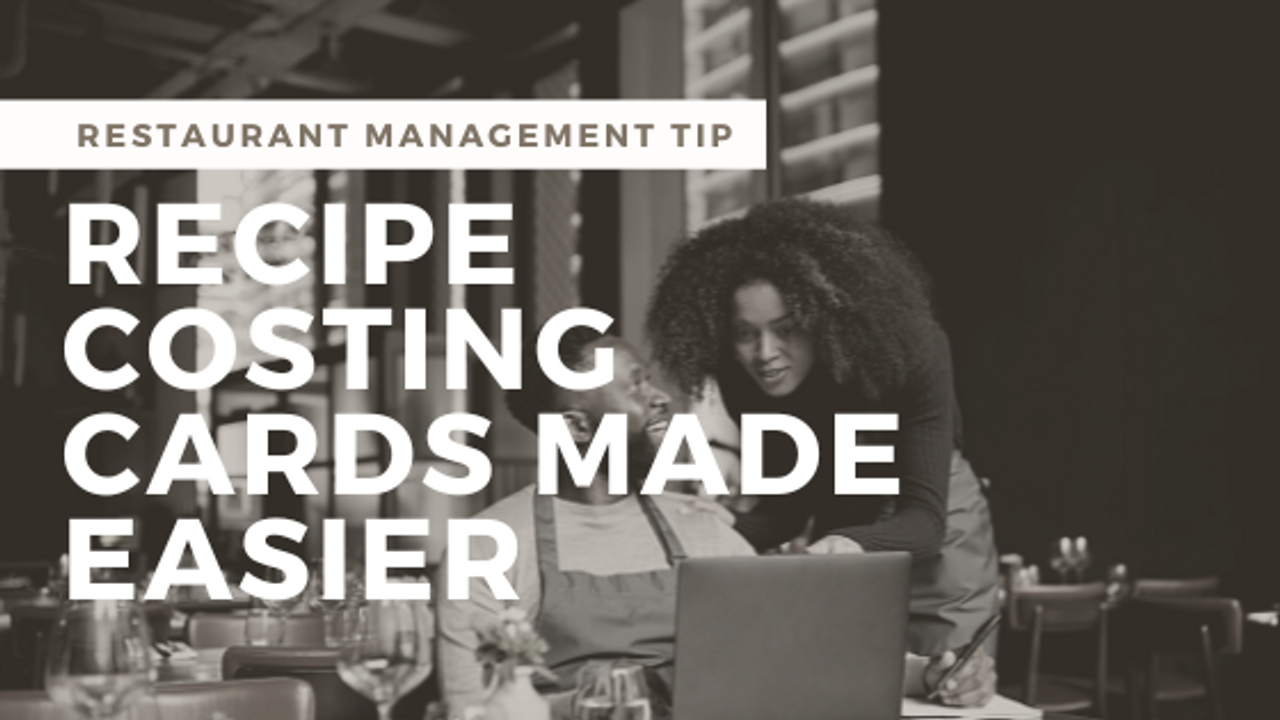How to Make Recipe Costing Cards Easier

If you've been following me for any length of time, you've heard me say the two most important systems any restaurant should have in place are recipe costing cards and budgets. Why? Because they're proactive systems that put you on the offensive for managing your restaurant. In this video, I focus on how to make restaurant recipe costing cards easier.
Let's start with why recipe costing cards are so important in the first place.
How do you know what to charge without recipe costing cards? Without them you are flying blind. To be successful you have to have certain knowledge about your business and recipe costing cards give you the ability to charge properly. Without them you can't know what your ideal food cost is. With accurate, up-to-date recipe costing cards, your product mix report from your POS system and what you sell each item for, you can discover what your ideal food cost is. That is what your food cost would be without waste, theft, spoilage, essentially a perfect restaurant, which does not exist. You want to know what your food cost should be, not try to match some national average.
When you have that ideal food cost, the way your kitchen should run, then you have the power to re-engineer your menu to make the money you deserve, often moving the needle anywhere from three to seven points down, changing your food cost.
Using your recipe costing cards and weekly inventories, you can use what I call the mic drop of all restaurant reports: your ideal versus actual product usage report. This tells you things like you’ve used 350 pounds of chicken, but you should have only used 300 pounds. With this kind of information, you know when there is a discrepancy and what could be affecting your food cost. You just highlight the line item and take it to your chef to fix.
Have I sparked your interest yet?
Let's get into how to make the process of recipe costing cards easier.
Number one: purchase food and beverage control software. This is critical. You can't do it with spreadsheets anymore. It cannot be done accurately, and you cannot maintain it properly. It takes too much time. You need software. I recommend a company called Margin Edge. The creators are restaurant operators who understand what it is to be in the trenches, and they built it with the operator in mind. I don’t get a commission if you use the link in this article, but it does help them know I sent you.
Number two: start mapping out your batch recipe costing cards. This is critical because all too often, chefs and kitchen managers start the recipe costing card process by diving in and starting with their chicken sandwich. That seems easier but your batch recipes are the priority. A batch recipe is anything you manufacture, anything you butcher up, chop up, recreate, put in a pot and cook. As a manufacturer of a product, you need to know what the cost is of each of those ingredients. Grab your menu, go straight down it and write down all the components of a dish you create. For example, if you sell 12 chicken wings, they are a batch recipe from a 40 pound case to each, five different sauces you make are five more batch recipes, you make your own Ranch dressing, that's a batch recipe. Carrots and celery? That’s two more batch recipes. You may have nine batch recipes before you can ever do the item recipe costing card.
Number three: using your software, upload all your invoices. Then go into the software and make your products easy to use, setting up the different units of measure from how you buy it, how you store it, how you use it, and multiple different ways that you can use it in a recipe easily.
Number four: document your actual recipes and how you execute them. You might think you’re sending out 5 ounces of fries, but if you’re not using portioning utensils, every person on the line is probably sending out different amounts. On a slow day, go in, ask your employees to stop, weigh it, write it down, and document how your recipes are actually going out the door.
Number five: start clicking on your ingredients. Go into the software and assemble your recipe, clicking on each item and amount that goes into it. Next thing you know, you've got recipe costing cards.
While of course there's more to this process, I am simplifying it to make sure you save time. See, if you follow the steps that I've outlined here, I promise you that you're going to take what is typically a 100-man-hour process and get it down to 40 to 60 man hours, all while remaining accurate and up to date every time a delivery shows up.
Not only will your recipe costing cards be up to date, but your next order is up to date and your next inventory is ready to go.
Don’t wait. Go to www.marginedge.com/dsp for David Scott Peters and sign up for a demo today. You'll be glad you did.
If you would like to learn how to own a restaurant that doesn't depend on you being in it to be successful, sign up for my free video course that teaches you three key principles to running a successful restaurant. If you're ready right now to make some serious changes in your restaurant, you can also book a 60-minute call with me where we talk about your challenges and figure out exactly what is holding you back from having a restaurant that doesn’t depend on you being in it to be successful.
Be sure to visit my YouTube channel for more helpful restaurant management video tips.




